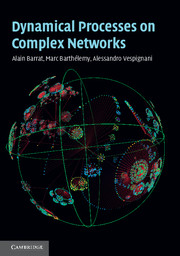Book contents
- Frontmatter
- Contents
- Preface
- Acknowledgements
- List of abbreviations
- 1 Preliminaries: networks and graphs
- 2 Networks and complexity
- 3 Network models
- 4 Introduction to dynamical processes: theory and simulation
- 5 Phase transitions on complex networks
- 6 Resilience and robustness of networks
- 7 Synchronization phenomena in networks
- 8 Walking and searching on networks
- 9 Epidemic spreading in population networks
- 10 Social networks and collective behavior
- 11 Traffic on complex networks
- 12 Networks in biology: from the cell to ecosystems
- 13 Postface: critically examining complex networks science
- Appendix 1 Random graphs
- Appendix 2 Generating functions formalism
- Appendix 3 Percolation in directed networks
- Appendix 4 Laplacian matrix of a graph
- Appendix 5 Return probability and spectral density
- References
- Index
9 - Epidemic spreading in population networks
Published online by Cambridge University Press: 05 September 2012
- Frontmatter
- Contents
- Preface
- Acknowledgements
- List of abbreviations
- 1 Preliminaries: networks and graphs
- 2 Networks and complexity
- 3 Network models
- 4 Introduction to dynamical processes: theory and simulation
- 5 Phase transitions on complex networks
- 6 Resilience and robustness of networks
- 7 Synchronization phenomena in networks
- 8 Walking and searching on networks
- 9 Epidemic spreading in population networks
- 10 Social networks and collective behavior
- 11 Traffic on complex networks
- 12 Networks in biology: from the cell to ecosystems
- 13 Postface: critically examining complex networks science
- Appendix 1 Random graphs
- Appendix 2 Generating functions formalism
- Appendix 3 Percolation in directed networks
- Appendix 4 Laplacian matrix of a graph
- Appendix 5 Return probability and spectral density
- References
- Index
Summary
The mathematical modeling of epidemics is a very active field of research which crosses different disciplines. Epidemiologists, computer scientists, and social scientists share a common interest in studying spreading phenomena and rely on very similar models for the description of the diffusion of viruses, knowledge, and innovation. Epidemic modeling has developed an impressive array of methods and approaches aimed at describing various spreading phenomena, as well as incorporating many details affecting the spreading of real pathogens. In particular, understanding and predicting an epidemic outbreak requires a detailed knowledge of the contact networks defining the interactions between individuals. The theoretical framework for epidemic spreading has thus to be widened with opportune models and methods dealing with the intrinsic system complexity encountered in many real situations.
In this chapter, we introduce the general framework of epidemic modeling in complex networks, showing how the introduction of strong degree fluctuations leads to unusual results concerning the basic properties of disease spreading processes. Using some specific examples we show how plugging in complex networks in epidemic modeling enables one to obtain new interpretative frameworks for the spread of diseases and to provide a quantitative rationalization of general features observed in epidemic spreading. We end the chapter by discussing general issues about modeling the spread of diseases in complex environments, and we describe metapopulation models which are at the basis of modern computational epidemiology.
- Type
- Chapter
- Information
- Dynamical Processes on Complex Networks , pp. 180 - 215Publisher: Cambridge University PressPrint publication year: 2008
- 2
- Cited by



